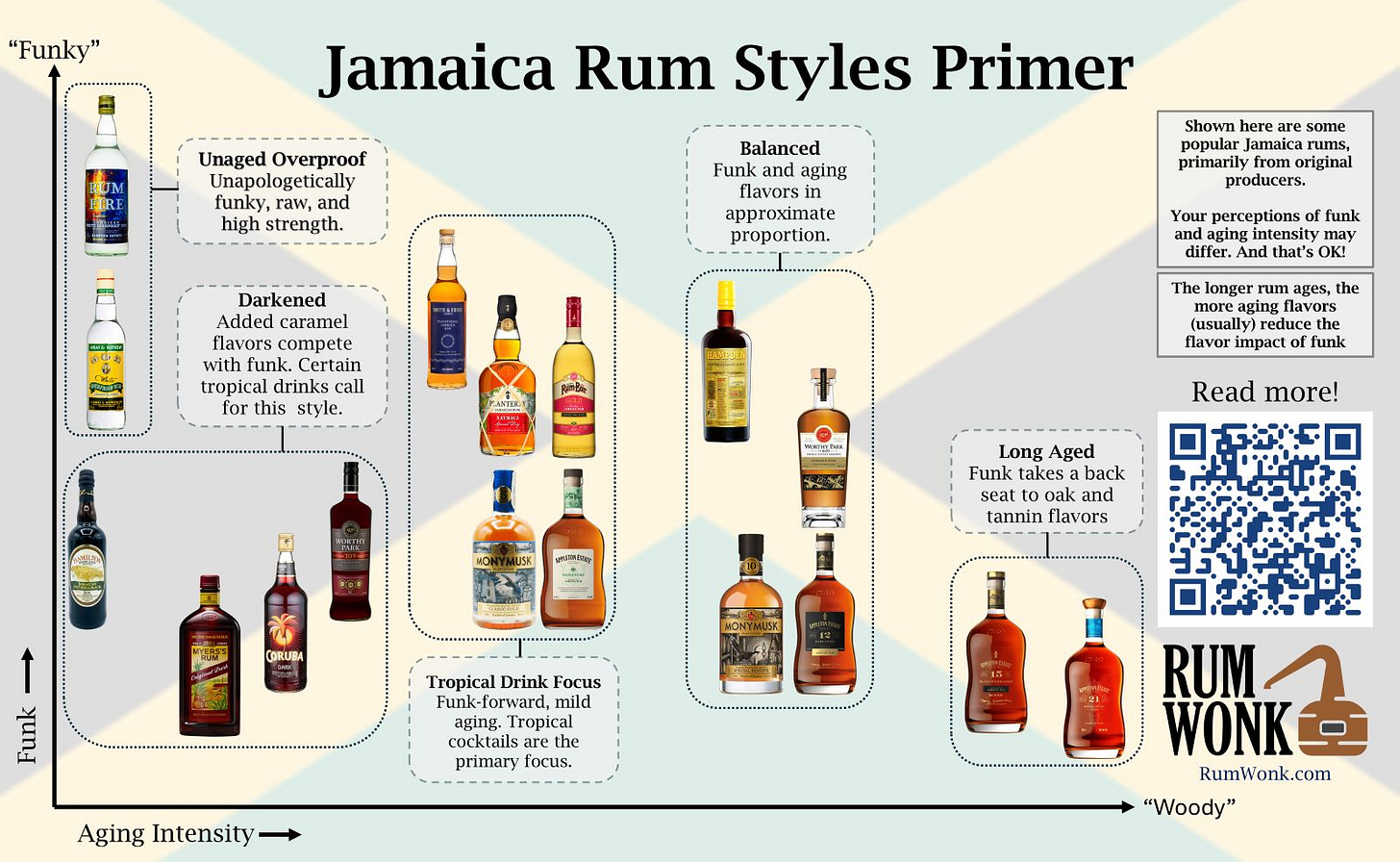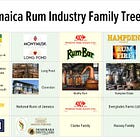Jamaica Rum Styles Primer
Once upon a time (decades ago), specifying “Jamaica rum” in a drink recipe was a reasonable thing to do. The readily available options were similar enough in style to be effectively interchangeable. (Trader Vic was partial to Red Heart and Myers’s.)
That’s no longer the case. Classifying rums solely by their origin is an anachronism.
Today, all Jamaican rum makers offer a wide range of products, from unaged, high-strength funk bombs to refined, long-aged expressions best enjoyed in a Glencairn. Modern drink recipes that simply say “Jamaica rum” leave a lot of room for interpretation; a Rum Fire Old Fashioned will be a very different experience than an Appleton 21 version.
Now, some may insist the above is just a matter of “mixing rums” versus “sipping rums.” I detest these terms; they’re far too reductive, suggesting, for example, that Smith & Cross can’t be enjoyed neat, while Appleton 21 has no place in a stirred drink. Likewise, commonly used rum classifications have challenges and are ill-suited for teasing out the peculiarities of Jamaica’s many rums.
Nonetheless, I contend that there’s value in loosely defining a small set of Jamaican substyles covering much of the available spectrum of rums. To do this, I took a fresh, flavor-based approach.
In a previous article, I posited that rum’s fermentation flavors and aging-induced flavors can be assessed independently. Starting from a decently sized set of popular, readily available Jamaican rums, I placed each of them on an X-Y grid. The X-axis represents aging flavor intensity, while the Y-axis represents fermentation flavor intensity.
Side note: Colloquially, many enthusiasts use funk as a non-scientific proxy for the flavors that derive from Jamaican rum fermentation. As a nod to this tradition, the Y-axis uses funk rather than more esoteric terminology, including esters and volatile organic compounds.
The infographic above is the result. Whenever multiple rums are in close proximity on the graph, we might have the making of a substyle. (Wonky note: the technical term for this approach is clustering.)
Yes, it’s a fool’s errand in trying to represent the many flavors found in Jamaican rum in just two dimensions. However, if we focus solely on the intensity of fermentation and aging flavors, we might discover something useful. Or at the very least, I’ll have sparked a spirited debate!
Disclaimers
First and foremost, taste is subjective—everyone experiences a mélange of flavors differently. One person’s perception that Smith & Cross is off-the-charts funky runs counter to another person’s feeling that Smith & Cross is on the lower end of the scale, especially when diluting it to, say, 43% ABV, the strength of Planteray’s Xaymaca.
So yes, the X-Y locations for each rum on the chart are my perception. You might disagree, and that’s OK!
Secondly, I can’t possibly squeeze everybody’s favorite rum into this chart. All the indie-bottled DOK, TECC, STCE, HLCF, and WPH rums are nowhere to be found, but if they were, the Y-axis would extend upward quite a bit. Instead, I focused (mostly) on rums which are readily available in multiple countries while taking care to include a spectrum of rums from each of Jamaica’s four rum makers.
As for the substyle names, I admit I wrestled with some of them, as did some close rum friends I sought feedback from. For certain substyles — I’m looking at you, Tropical Drink Focus— any alternate names we discussed were too vague, too technical, or too lengthy. If you have better name ideas, please send them to me or add them in the comments.
Jamaica Rum Substyles
What follows are my very brief notes about each of the substyles, including examples of expressions that aren’t in the graph due to space constraints.
Generally speaking, Appleton’s rums tend to rely on aging-induced flavors and are typically the least funky in any substyle. Hampden’s rums strike a very different tone: unapologetically driven primarily by fermentation funkiness. While we’re yet to see a distillery-aged Hampden with 15+ years of aging, I imagine we will someday. (Yes, there are long-aged Hampdens available, but the continental aging is the norm here.)
Worthy Park and NRJ’s brands (Monymusk, Long Pond) typically fall between the extremes of Appleton and Hampden. (Again, high-ester indie-bottled marques are out of scope here.)
Unaged Overproof
This is the easiest substyle to identify. These rums are all unaged and range in ABV from 63% to 65%. Wray & Nephew was the originator of this style, dating back to the late 1950s. All the other first appeared in the last twenty years. They vary substantially in flavor intensity, with the Wray & Nephew and Monymusk towards the lower end of the scale, and Rum Fire and Charley’s JB at the upper end.
Wray & Nephew White Overproof
Worthy Park White Overproof/ Rum Bar Overproof
Monymusk Overproof White
Rum Fire
Charley’s JB
Darkened
Historically, some Jamaica rums were substantially colored with a strong dose of sugarcane-based caramel, enough to noticeably influence flavor as well. Today’s newer Jamaica rums generally don’t add as much caramel, with Worthy Park 109 a notable exception.
A quick peek at the X-axis for this substyle dispels the notion that “dark Jamaica” rums were longer aged; quite the opposite, in fact. When a drink recipe from before the 1980s calls for dark Jamaica rum, look at the darkened substyle first.
Myers’s Original Dark
Coruba
Worthy Park 109
Hamilton Jamaica Black
Tropical Drink Focus
These rums are funky enough to stand out in most tropical cocktails despite jostling for attention among strong citrus and spice notes. While they can be enjoyed neat by those familiar with the gamut of Jamaica rums, they sometimes have some exposed edges. Still, they won’t punch you in the nose like the unaged overproofs will.
Monymusk Classic Gold
Worthy Park Select
Rum Bar Gold
Appleton Signature
Smith & Cross
Doctor Bird
Hampden Estate 1753
Stolen Jamaica Overproof
Balanced
Aging and fermentation funk flavors meet in the middle with the balanced substyle. The “hogo” is still there, but with the sharper edges rounded off and replaced by the warm, oaky tones familiar to whiskey drinkers. If you want to introduce a bourbon drinker to rum, and aren’t looking at Barbados rums, the balanced substyle is a good place to start.
Hampden Estate 8 Years
Worthy Park Single Estate
Monymusk Special Reserve
Appleton 8
Appleton 12
Appleton Legend
Long Aged
15+ years of aging in Jamaica’s tropical climate bring aging flavors to the foreground. During that time, wood-derived flavors intensify and meld together with the remaining funk. To truly experience all that this substyle offers, simply pour it into a glass and enjoy. Sure, you can make a “Millionaire Mai Tai” with the long-aged Jamaicans, but the flavors that took so long to develop may be lost in the mix amongst a torrent of citrus and spice. On the other hand, an Old Fashioned made with these rums is sublime!
Appleton 15
Appleton 21
Long Pond MSR
Long Pond ITP 15
Long Pond VRW
Conclusion
The above isn’t intended to be the ultimate guide to Jamaica rum. Rather, the goal is to introduce you to thinking about the diversity of Jamaica rums while pointing out similarities between different expressions. And if you enjoy Jamaica rum in cocktails, you’ll have some ideas about other similar rums to experiment with.
Drop your thoughts in the comments! And if you like what you see here, consider subscribing below. It’s free!









Is it really true to say that all brands of white Jamaican overproof other than Wray & Nephew appeared in the last 20 years?
Obviously Worthy Park is a new distillery, and Hampden and Monymusk only recently began bottling rums under their own brand names. So in that sense the current main competitors to Wray & Nephew Overproof are new.
But going back further weren't there other brands? I'm thinking of things like Sangster's Conquering Lion, Charley's JB, probably also Estate Rum (aka Redface), etc. There must be others that have come and gone over the years. The above are just examples you can still find on a shelf today.
Great read as always Mr. Wonk. I’m trying to get my family to see rum as it is, the most versatile spirit on the market(imo) and this will surely help.